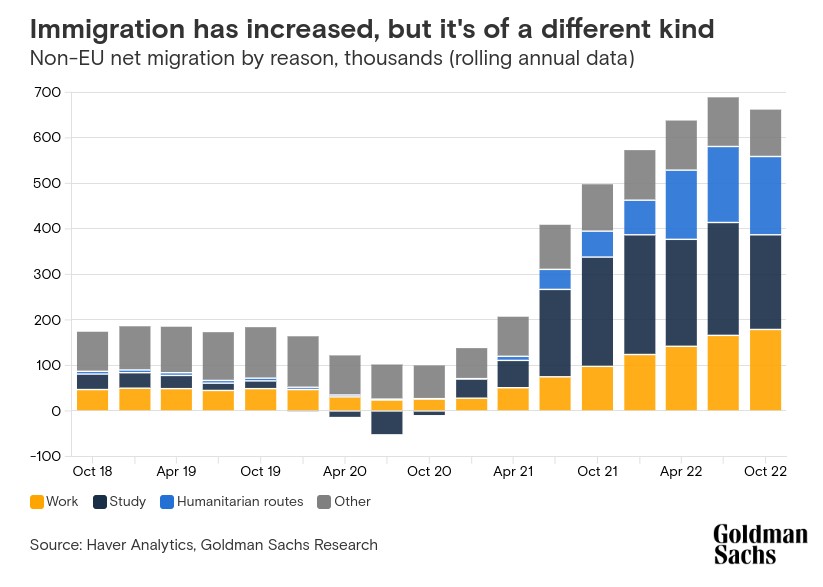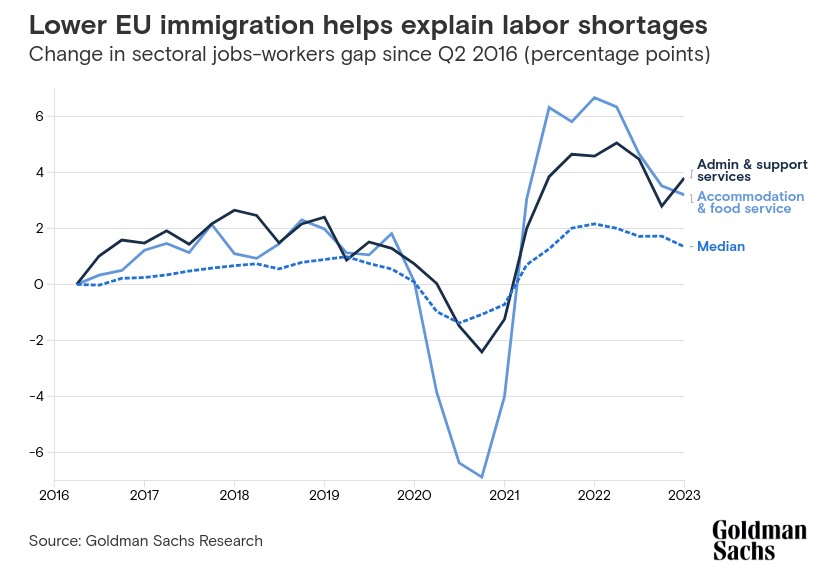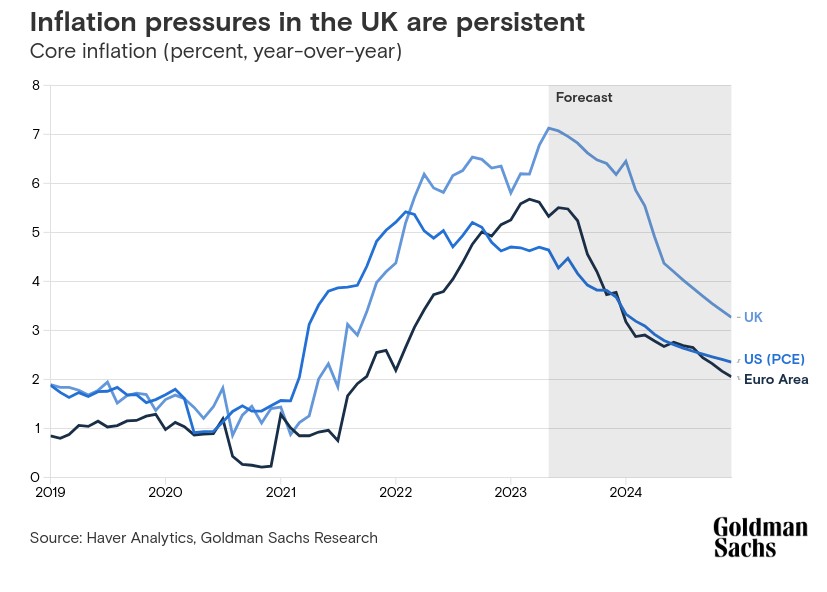We would like to thank our generous sponsors for making this article possible.
As the U.K. contends with one of the highest inflation rates among advanced economies, there are signs that a drop in immigration from the Continent has contributed to an overheated job market as well as higher inflation, according to Goldman Sachs Research. And while overall immigration has increased since Britons voted to leave the EU, more people are coming to the U.K. from outside of Europe, and many are migrating for humanitarian reasons and to study.
European migration meaningfully reduced labor market tightness in the U.K. after EU enlargement in 2004, when a number of countries joined the bloc, Goldman Sachs economists James Moberly and Sven Jari Stehn write in the team’s report. This effect unwound as migration (on net) fell after the Brexit vote in 2016. While a number of factors, from volatile energy prices to Covid-era supply chain bottlenecks, have contributed to inflation, they find that the tight labor market is part of the reason inflation been particularly stubborn in Britain: Core inflation rose 7.1% in May (year-over-year) — compared with 5.3% in the U.S. — and regular private sector pay increased 7.9% in April (year-over-year).
Resilient demand for workers is probably part of the reason for these wage and inflation pressures. But Goldman Sachs Research has found that the availability of labor has also had an important role, as the supply of workers is still around pre-Covid levels. By contrast, labor forces in the likes of Canada and the euro area have increased notably.

The U.K.’s relative lack of additional workers is often attributed to Brexit, which curtailed the movement of workers between Britain and the EU. But total immigration into the U.K. has actually been higher than before the EU referendum, Moberly and Stehn write. Net long-term international immigration stood at 606,000 in 2022, compared with 329,000 in 2015.
From our partners:
Beneath the surface, meanwhile, the structure of immigration has changed materially. The post-Brexit migration regime introduced in 2021 has shifted from one that allowed free movement for EU workers and was restrictive for non-EU workers, to one that is based on skills instead of geography.
As a result, immigration from the EU has dropped off sharply, especially from Eastern Europe, while inflows from outside the EU have risen notably. At the same time, the main reason for immigration has shifted from people looking for work in the U.K. toward humanitarian reasons and study. By contrast, net inflows from the EU were predominantly work-related in the period before the Brexit vote.

Goldman Sachs Research finds that, before the referendum, migrants from the EU were concentrated in lower-skilled occupations. This was led by service jobs that had historically been dependent on workers from the EU.
The sectors that used to have the highest inflow of EU workers have also had the largest rise in vacancy rates and the greatest increase in the jobs-workers gap — the difference between the total number of jobs (in other words, employment plus job openings) and the total number of workers, Moberly and Stehn write. Migrants from the EU were concentrated in lower-skilled occupations; jobs in agriculture, accommodation and food services, and support services historically had the highest percentage of workers from the bloc.

The influx of non-EU workers will only partially offset the gap in needed workers, Moberly and Stehn write. The new migration regime is based on skills and will preclude migration from easing labour market tightness in some of the most cyclical sectors that ebb and flow with the strength of the economy. They expect this to make the labor market for these sectors tighter and more volatile. (There could be more of an offset from non-EU migration in the near-term, however, because the rise in humanitarian inflows reduces the extent to which migration flows are based on skills.)
This calls into question whether non-EU immigration can offset business cycle fluctuations as free movement of EU workers did. Participation rates for non-EU workers are still well below those for EU workers. “These cyclical inflows likely helped to ease labor market tightness and recruitment difficulties in specific sectors in periods when demand was strong,” they write.
Another key question is whether immigration contributes more to labor market supply or to labor demand. Moberly and Stehn suggest that these workers may add less to demand than other workers because many immigrants send part of their earnings abroad as remittances, and those not planning to stay in the U.K. for a longer period of time may purchase fewer durable goods. At the same time, immigrants from the EU may add more to the labor supply because they have a high participation rate.
“Overall, then, net migration from the EU in the period after 2004 likely added more to supply than demand,” Moberly and Stehn write. “Because the inflows were procyclical, they likely dampened fluctuations in the output gap and labor market tightness, and consequently inflationary pressures.”

Moberly and Stehn constructed a macroeconomic model that captures the way migration, demand shocks, and inflation interact with each other. The results of that model are consistent with the notion that migration from the EU before Brexit eased labour market tightness, and because migration was cyclical it tended to ease the effect of demand shocks on inflation. “Nonetheless, we acknowledge that there is considerable uncertainty around the size of these effects given the difficulty in disentangling the impact of changes in migration from other shocks,” they write.
“Taken together, our findings indicate that the post-Brexit change in immigration flows has contributed to the overheating of the UK’s labour market, although the magnitude of the effect is difficult to pin down,” Moberly and Stehn add. “This supports our view that much of the required rebalancing of the labour market will have to come via slower demand but, given resilient growth, will be a slow process.”
As U.K. inflation runs hot, the Bank of England surprised markets last week by raising its main rate by 50 basis points. Our economists expect the U.K. to have resilient growth, sticky wage increases, and stubbornly high core inflation, and they forecast a second 50 basis point hike in August (versus 25 basis before last week’s BOE meeting). Goldman Sachs Research expects the BOE to make a final 25 basis point hike in September, and last week our economists raised their forecast for the terminal rate to 5.75% (versus 5.5% before).
Our economists don’t expect wage increases to fall to the 3% rate required for 2% inflation anytime soon. “We therefore expect U.K. core inflation to remain notably above other advanced economies, suggesting that the BOE still has quite a lot of work to do,” Moberly and Stehn write.
Originally published at: Goldman Sachs













